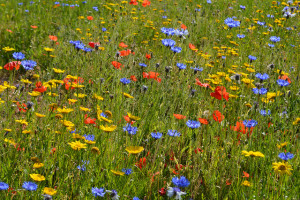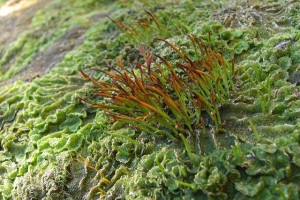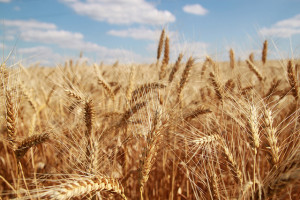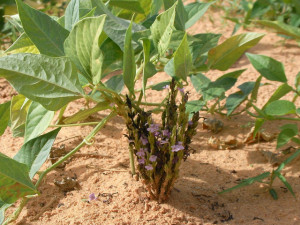


The 1000 plants initiative (1KP) is a multidisciplinary consortium aiming to generate large-scale gene sequencing data for over 1000 species of plants. Included in these species are those of interest to agriculture and medicines, as well as green algae, extremophytes and non-flowering plants. The project is funded by several supporters, and has already generated many published papers.
Gane Wong is a Professor in the Faculty of Science at the University of Alberta in Canada. Having previously worked on the Human Genome Project, he now leads the 1KP initiative. Dennis Stevenson, Vice President for Botanical Research, New York Botanical Garden, and Adjunct Professor, Cornell University (USA), studies the evolution and classification of the Cycadales. He became involved in the 1KP initiative as an opportunity to sample the breadth of green plant diversity.
We spoke to both Professor Stevenson (DS) and Professor Wong (GW) about the initiative. Professor Douglas Soltis from Florida Museum of Natural History also contributed to this blog post with input in editing the answers.
What do you think has been the biggest benefit of 1KP?
DS: This has been an unparalleled opportunity to reveal and understand the genes that have led to the plant diversity we see around us. We were able to study plants that were pivotal in terms of plant evolution but which have not previously been included in sequencing projects as they are not considered important economically

The 1KP project presented a fantastic opportunity to explore plant biodiversity. Photo by Bob Leckridge. Used under Creative Commons 2.0.
GW: The project was funded by the Government of Alberta and the investment firm Musea Ventures to raise the profile of the University of Alberta. Notably there was no requirement by the funders to sequence any particular species. I was able to ask the plant science community what the best possible use of these resources would be. The community was in full agreement that the money should be used to sample plant diversity.
Hopefully our work will change the thinking at the funding agencies regarding the value of sequencing biodiversity.
What techniques were utilized in this project to carry out the research?
GW: Complete genomes were too expensive to sequence. Many plants have unusually large genomes and de novo assembly of a polyploid genome remains difficult. To overcome this problem, we sequenced transcriptomes. However, this made our sample collection more difficult as the tissue had to be fresh. In addition, when we started the project, the software to assemble de novo transcriptomes did not work particularly well. I simply made a bet that these problems would be solved by the time we collected the samples and extracted the RNA. For the most part that’s what happened, although we did end up developing our own assembly software as well!
The 1KP initiative is an international consortium. How has the group evolved over time and what benefits have you seen from having this diverse set of skills?
GW: 1KP would not be where it is today without the participation of scientists around the world from many different backgrounds. For example, plant systematists who defined species of interest and provided the tissue samples worked alongside bioinformaticians who analyzed the data, and gene family experts who are now publishing fascinating stories about particular genes.
DS: One of the great things about this project is how it has evolved over time as new researchers became involved. There is no restriction on who can take part, which species can be studied or which questions can be asked of the data. This makes the 1KP initiative unique compared to more traditionally funded projects.
GW: We continually encouraged others to get involved and mine our data for interesting information. We did a lot of this through word of mouth and ended up with some highly interesting, unexpected discoveries. For example, an optogenetics group at MIT and Harvard used our data to develop new tools for mammalian neurosciences. This really highlights the importance of not restricting the species we study to those of known economic importance.
According to ISI outputs from this research, two of the most highly cited papers from 1KP are here and here.
You aimed to investigate a highly diverse array of plants. How many plants of the major phylogenetic groups have now been sequenced, and are you still working on expanding the data set?
DS: A lot of thought went into the species selection. We aimed for proportional representation (by number of species) of the major plant groups. We also aimed to represent the morphological diversity of those groups.
GW: Altogether, we generated 1345 transcriptomes from 1174 plant species.
Has this project lead to any breakthroughs in our understanding of the phylogeny of plants?
DS: This will be the first broad look at what the nuclear genome has to tell us, and the first meaningful comparison of large nuclear and plastid data sets. However, due to rapid evolution plus extinction, many parts of the plant evolutionary tree remain extremely difficult to solve.

Hornworts are non-vascular plants that grow in damp, humid places. Photo by Jason Hollinger. Used under Creative Commons License 2.0.
One significant breakthrough was the discovery of horizontal gene transfer from a hornwort to a group of ferns. This was unexpected and very interesting in terms of the ability of those ferns to be able to accommodate understory habitats.
GW: With regard to horizontal gene transfer, there are papers in the pipeline that will illustrate the discovery of even more of these events in other species. We have also studied gene duplications at the whole genome and gene family level. This is the most comprehensive survey ever undertaken, and people will be surprised at the scale of the discoveries. However, we will be releasing our findings shortly as part of a series and it would be unwise for us to give the story away here! Keep a look out for these!
With another year nearly over we recently put out a call for nominations for the Most Influential Plant Science Research of 2015. Suggestions flooded in, and we also trawled through our social media feeds to see which stories inspired the most discussion and engagement. It was fantastic to read about so much amazing research from around the world. Below are our top five, selected based on impact for the plant science research community, engagement on social media, and importance for both policy and potential end product/application.
Choosing the most inspiring stories was not an easy job. If you think we’ve missed something, please let us know in the comments below, or via Twitter! In the coming weeks we’ll be posting a 2015 Plant Science Round Up, which will include other exciting research that didn’t quite make the top five, so watch this space!

Sweet potato contains genes from bacteria making it a naturally occurring GM crop. Image from Mike Licht used under creative commons license 2.0
Scientists at the International Potato Center in Lima, Peru, found that 291 varieties of sweet potato actually contain bacterial genes. This technically means that sweet potato is a naturally occurring genetically modified crop! Alongside all the general discussion about GM regulations, particularly in parts of Europe where regulations about growing GM crops have been decentralized from Brussels to individual EU Member States, this story caused much discussion on social media when it was published in March of this year.
It is thought that ancestors of the modern sweet potato were genetically modified by bacteria in the soil some 8000 years ago. Scientists hypothesize that it was this modification that made consumption and domestication of the crop possible. Unlike the potato, sweet potato is not a tuber but a mere root. The bacteria genes are thought to be responsible for root swelling, giving it the fleshy appearance we recognize today.
This story is incredibly important, firstly because sweet potato is the world’s seventh most important food crop, so knowledge of its genetics and development are essential for future food supply. Secondly, Agrobacterium is frequently used by scientists to artificially genetically modify plants. Evidence that this process occurs in nature opens up the conversation about GM, the methods used in this technology, and the safety of these products for human consumption.
Read the original paper in PNAS here.
Our number two on the list also relates to genetic modification, this time focusing on methods. Regardless of whether or not we want to have genetically modified crops in our food supply, GM is a valuable tool used by researchers to advance knowledge of gene function at the genetic and phenotypic level. Therefore, systems of modification that make the process faster, cheaper, and more accurate provide fantastic opportunities for the plant science community to progress its understanding.
The Cas9 system is a method of genome editing that can make precise changes at specific locations in the genome relatively cheaply. This novel system uses small non-coding RNA to direct Cas9 nuclease to the DNA target site. This type of RNA is small and easy to program, providing a flexible and easily accessible system for genome editing.

Barley in the field. Image by Moldova_field used under creative commons license 2.0
Inheritance of genome modifications using Cas9 has previously been shown in the model plants, Arabidopsis and rice. However, the efficiency of this inheritance, and therefore potential application in crop plants has been questionable.
The breakthrough study published in November by researchers at The Sainsbury Laboratory and John Innes Centre both in Norwich, UK, demonstrated the mutation of two commercial crop plants, Barley and Brassica oleracea, using the Cas9 system and subsequent inheritance mutations.
This is an incredibly exciting development in the plant sciences and opens up many options in the future in terms of genome editing and plant science research.
Read the full paper in Genome Biology here.
Striga is a parasitic plant that mainly affects parts of Africa. It is a major threat to food crops such as rice and corn, leading to yield losses worth over 10 billion US dollars, and affecting over 100 million people.
Striga infects the host crop plant through its roots, depriving them of their nutrients and water. The plant hormone strigolactone, which is released by host plants, is known to induce Striga germination when host plants are nearby.
In a study published in August of this year the Striga receptors for this hormone, and the proteins responsible for striga germination were identified.
Striga plants are known to wither and die if they cannot find a host plant upon germination. Induction of early germination using synthetic hormones could therefore remove Striga populations before crops are planted. This work is vital in terms of regulating Striga populations in areas where they are hugely damaging to crop plants and people’s livelihoods.
Read the full study in Science here.

Striga, a parasitic plant. Also known as Witchweed. Image from the International Institute of Tropical Agriculture used under creative commons license 2.0
Resurrection plants are a unique group of flora that can survive extreme water shortages for months or even years. There are more than 130 varieties in the world, and many researchers believe that unlocking the genetic codes of drought-tolerant plants could help farmers working in increasingly hot and dry conditions.
During a drought, the plant acts like a seed, becoming so dry that it appears dead. But as soon as the rains come, the shriveled plant bursts ‘back to life’, turning green and robust in just a few hours.
In November, researchers from the Donald Danforth Plant Science Centre in Missouri, US, published the complete draft genome of Oropetium thomaeum, a resurrection grass species.
O. thomaeum is a small C4 grass species found in Africa and India. It is closely related to major food feed and bioenergy crops. Therefore this work represents a significant step in terms of understanding novel drought tolerance mechanisms that could be used in agriculture.
Read the full paper in Nature here.
Currently, one of the greatest challenges for ecologists is to quantify plant diversity and understand how this affects plant survival. For the last 500 years independent research groups around the world have collected this diversity data, which has made organization and collaboration difficult in the past.
Over the last 500 years, independent research groups have collected a wealth of diversity data. The Botanical Information and Ecology Network (BIEN) are collecting and collating these data together for the Americas using high performance computing (HPC) and data resources, via the iPlant Collaborative and the Texas Advanced Computing Center (TACC). This will allow researchers to draw on data right from the earliest plant collections up to the modern day to understand plant diversity.
There are approximately 120,000 plant species in North and South America, but mapping and determining the hotspots of species richness requires computationally intensive geographic range estimates. With supercomputing the BIEN group could generate and store geographic range estimates for plant species in the Americas.
It also gives ecologists the ability to document continental scale patterns of species diversity, which show where any species of plant might be found. These novel maps could prove a fantastic resource for ecologists working on diversity and conservation.
Read more about this story on the TACC website, here.